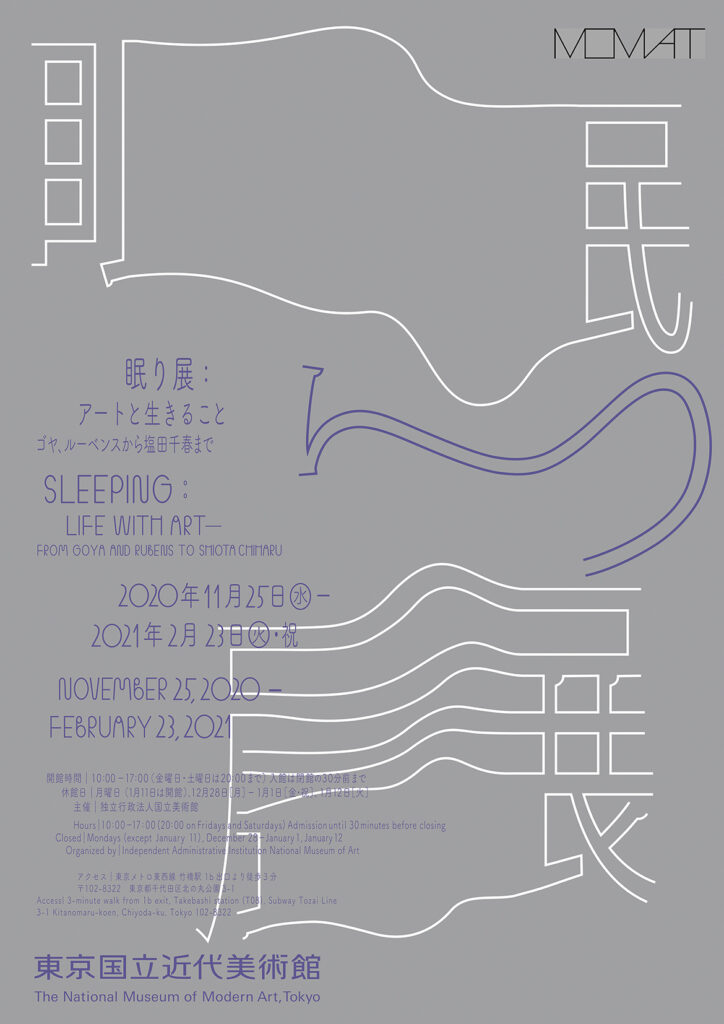Exhibitions
Sleeping: Life with Art – From Goya and Rubens to Shiota Chiharu
Date
-Location
Special Exhibition Gallery (1st floor)
About
Forms of Sleep as Seen in Works from the National Museum of Art’s Collections
Sleep is not only an essential part of human life, but it has also fueled artists’ creativity. Presenting 120 works of various genres, including paintings, prints, sketches, photographs, three-dimensional works, and videos, this exhibition asks the viewer to consider how each work expresses the theme of sleep and what it might be trying to convey.
Works of art produced on the theme of sleep will give us hints about our everyday doubts and worries from perspectives different from those we have while waking.
About the National Museum of Art
The Independent Administrative Institution National Museum of Art consists of six members: the National Museums of Modern Art in Tokyo and Kyoto; the National Museum of Western Art, Tokyo; the National Museum of Art, Osaka; the National Art Center, Tokyo; and the National Film Archive of Japan. Comprising a total of forty-four thousand items including paintings, photographs, videos, and designs from all periods since before Christ, their collections are national treasures that we want as many people as possible to appreciate.

Designed by Hirano Atsushi
(AFFORDANCE. inc)
Contents
Guided by Francisco de Goya, a master who was active from the eighteenth to nineteenth centuries, this exhibition explores the possibilities of sleep for art in seven chapters including an introduction and a conclusion.
Introduction: Closing Your Eyes
Sleep begins when you close your eyes. The act of closing the eyes might seem defenseless and unreliable. On the other hand, it enables you to calmly face yourself.
Section 1: Dream or Reality?
You live going back and forth between dreams and reality. Sometimes you are uncertain where you are, in between a dream and reality. Sleep connects a dream or unreality to reality, existing in a continuum between the two.
Section 2: The Sorrow of Life
As in the phrase “eternal sleep,” sleep is often likened to death. While it is essential for life, it is the other side of death. This section focuses on struggles to live next to death.
Section 3: I am Not Merely Sleeping
A seemingly simple figure of a sleeper may carry different meanings that can be extracted by considering historical contexts or superimposing it on the present circumstances.
Section 4: Waiting to wake
A wake-up follows sleep. A sleeper makes you expect a future wake-up. This section focuses on wake-ups seen in art.
Section 5: Kawara On: Sleep as Proof of Existence
This chapter explores the relationships between sleep and wake-ups, or life and death through works by Kawara On (1932–2014), a leader in postwar Japanese art.
Conclusion: Closing Your Eyes Again
The range of meanings of sleep and closed eyes in art is amazingly extensive. You will be able to notice different implications in a seemingly simple figure of a sleeper or one with closed eyes. The act of closing your eyes, while it means you surrender yourself to others’ eyes, gives you an opportunity to think about your past and future and meditate calmly. Works showing figures with their eyes closed will give us hints for reviewing our past daily life and think about how we should live in the future.
Exhibition Catalogue
Hours & Admissions
- Location
-
Special Exhibition Gallery (1st floor)
- Date
-
November 25, 2020 – February 23, 2021
- Time
-
10:00-17:00
*Last admission : 30 minutes before closing. - Closed
-
Mondays (except January 11, 2021) , from December 28 to January 1, 2021, and on January 12, 2021
- Ticket
-
Advance ticket is recommended to avoid lines forming at the entrance.
Online purchase: 【e-tix】
Tickets can be purchased on site at the ticket counters, subject to their availability. - Admission
-
Adults: ¥1,200( 1,000 )
College / University students: ¥600( 500 )- Including the admission fee for MOMAT Collection.
- Admission in the parentheses is for groups of 20 persons or more.
- All prices include tax.
- Admission is free for high school students, under 18, and those with Disability Certificates and one caregiver accompanying each of them. Please present ID at the entrance.
- Admission is free for students and staff members of schools participating in the Campus Members Program. Please present ID at the entrance.
- Organizer
-
The Independent Administrative Institution National Museum of Art



